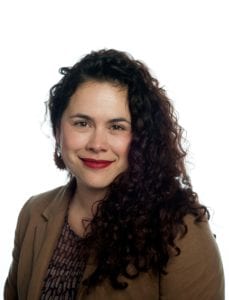
Director for Recruitment and Inclusion for Graduate Programs in Bioscience
University of California, Los Angeles (UCLA)
Dr. Azurdia earned her BS in Biochemistry from California State University (CSU) Los Angeles, where she was a National Institutes of Health (NIH) Maximizing Access to Research Careers (MARC) trainee. She later earned her PhD in Molecular Biology and Biochemistry from UCLA, where she was a National Institute of General Medical Sciences (NIGMS) Predoctoral Fellow (F31). Dr. Azurdia is a first-generation Guatemalan-American and the first in her family to attend college. In her role at UCLA, Dr. Azurdia leads the development and implementation of a strategic plan to enhance diversity in the biomedical graduate student population.
Grace Kwon, ASHG: Can you describe your current role and position at UCLA?
Dr. Azurdia: I am the Director for Recruitment and Inclusion to the Graduate Programs in Bioscience, which is an umbrella program of 10 interdepartmental groups and their affiliated PhD programs. My position title is academic administrator—this position allows me to teach, do research, and take on other duties that faculty would typically take on rather than staff. I am responsible for all of our inclusion efforts and implementing programmatic activities that are inclusive and enhance our students’ ability to thrive in our PhD programs.
Part of my job includes performing research on our student outcomes and designing data driven interventions and programing where necessary. For example, I have been looking at the publication rates of graduate students in our programs during their doctoral years. My data suggest that there may be a disparity in publication rates between groups of different demographics.
This is not UCLA-specific, and other studies have shown a similar trend—in fact, these studies were the impetus for digging into our own data. Part of my job is to pursue this investigation further and to determine why this disparity exists—whether that be mentorship, self-efficacy, etc.—and to design an intervention for addressing it. A commitment to inclusion requires evaluating institutional practices and outcomes to reveal where disparities exist so that they can be addressed.
ASHG: Did you know this was the career you wanted to pursue during your training? How did you learn about and transition to this career?
Dr. Azurdia: When I first started graduate school, I had aspirations of becoming faculty. However, as I went through my PhD training, I began to realize how important the role of mentorship and inclusion was to my training experience. For me, the lack of a productive mentoring relationship and avenues for addressing that were having a negative impact on my self-efficacy as a scientist.
Consequently, my graduate work ended up moving very slowly and I suffered from quite a bit of Imposter Syndrome; furthermore, it didn’t really help that there were very few faculty and peers who looked like me or came from a similar background that I could talk to about the challenges I was experiencing.
Because my graduate program (at the time) did not have a diverse faculty or student body, I co-founded a diversity seminar speaker series and invited prominent scientists of color to give talks with funding we secured from Proctor & Gamble. This really validated my existence in science, because I started to see other scientists of color doing great work and receiving recognition. This experience was my first real glimpse into a career possibility outside the research bench, one that focused on STEM higher education and inclusion initiatives.
After my PhD, I was an adjunct faculty member at CSU Los Angeles in the biochemistry department for a few years, and although I really loved teaching biochemistry, it didn’t fulfill my desire to further inclusion efforts. Following that, I pursued an Assistant Director position at the Undergraduate Research Center (URC) Sciences at UCLA. I was attracted to this position because it was a chance to contribute to broadening participation in STEM through directing undergraduate research programs, such as the MARC program.
While I began my role as Assistant Director in the URC at UCLA, I also wasn’t fully convinced I was ready to leave the lab bench yet, so I also had a part-time postdoctoral position in the obstetrics and gynecology department studying triple negative breast cancer. I would get out of work in the URC at 4 PM, then go work in the lab until 11 PM and on weekends. I still loved doing research, but there was an “aha” moment that I knew STEM education and outreach was more fulfilling for me. That’s when I fully realized I could step away from the lab bench.
ASHG: How can trainees promote a healthy training environment that is diverse and inclusive?
Dr. Azurdia: People should use their privilege to support others. For instance, if you are in a research environment where women are consistently being talked over or their ideas are being attributed to a male colleague, someone with power in the group should call out these microaggressions and find ways to bring those at the fringe to the forefront.
At UCLA, one thing we work on is building communities for students. While it is an umbrella program of multiple departments, we try to have students from different departments come together to meet and discuss ideas, share stories, or find a safe space to discuss hard topics. Creating this environment where students can discuss difficult topics and ask for what they need is important.
There is this idea that science is only for those who are “geniuses” or those with “good hands”, but that is not the case, and we have to dismantle this notion as it creates barriers to participation.
Further Reading:
